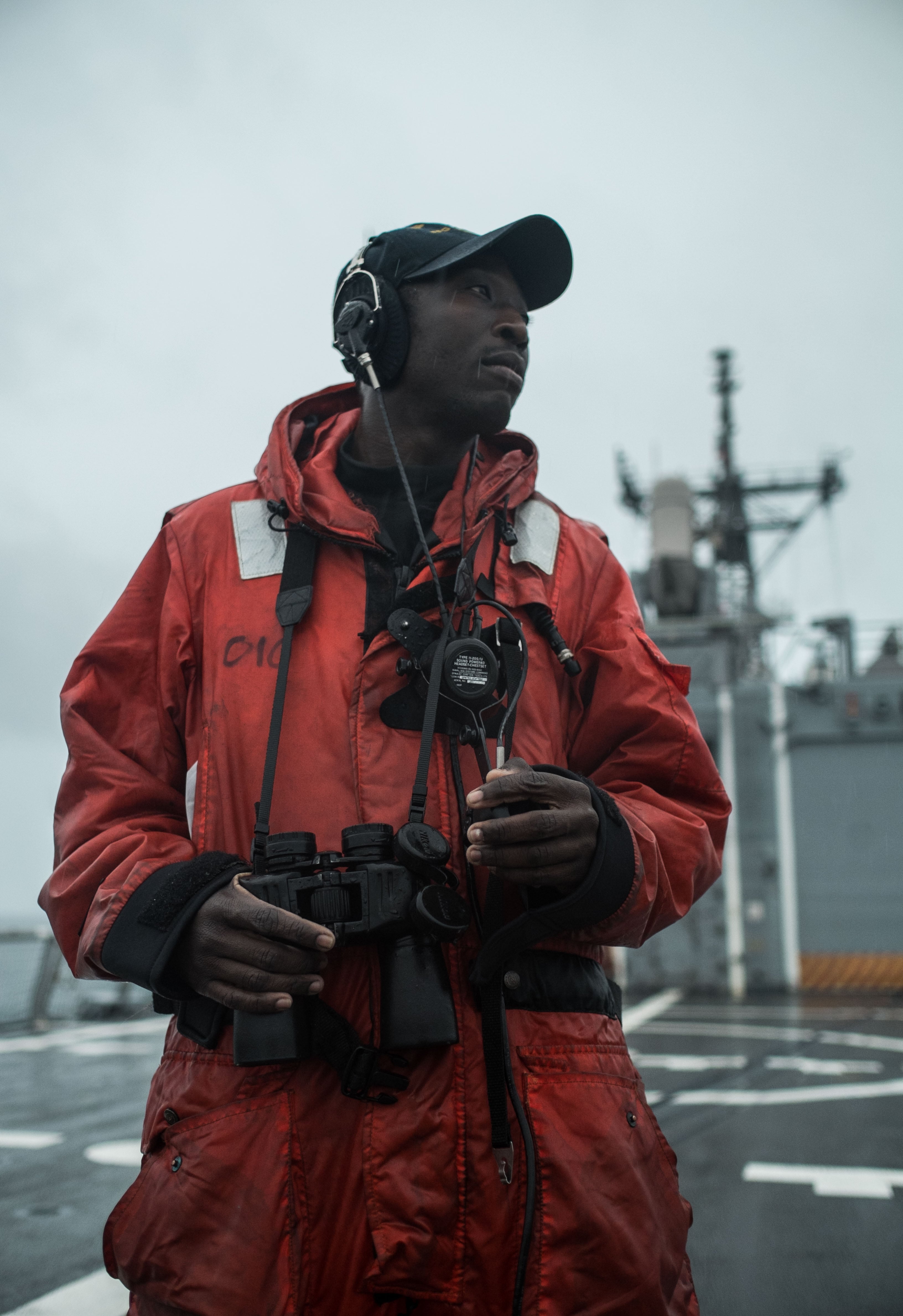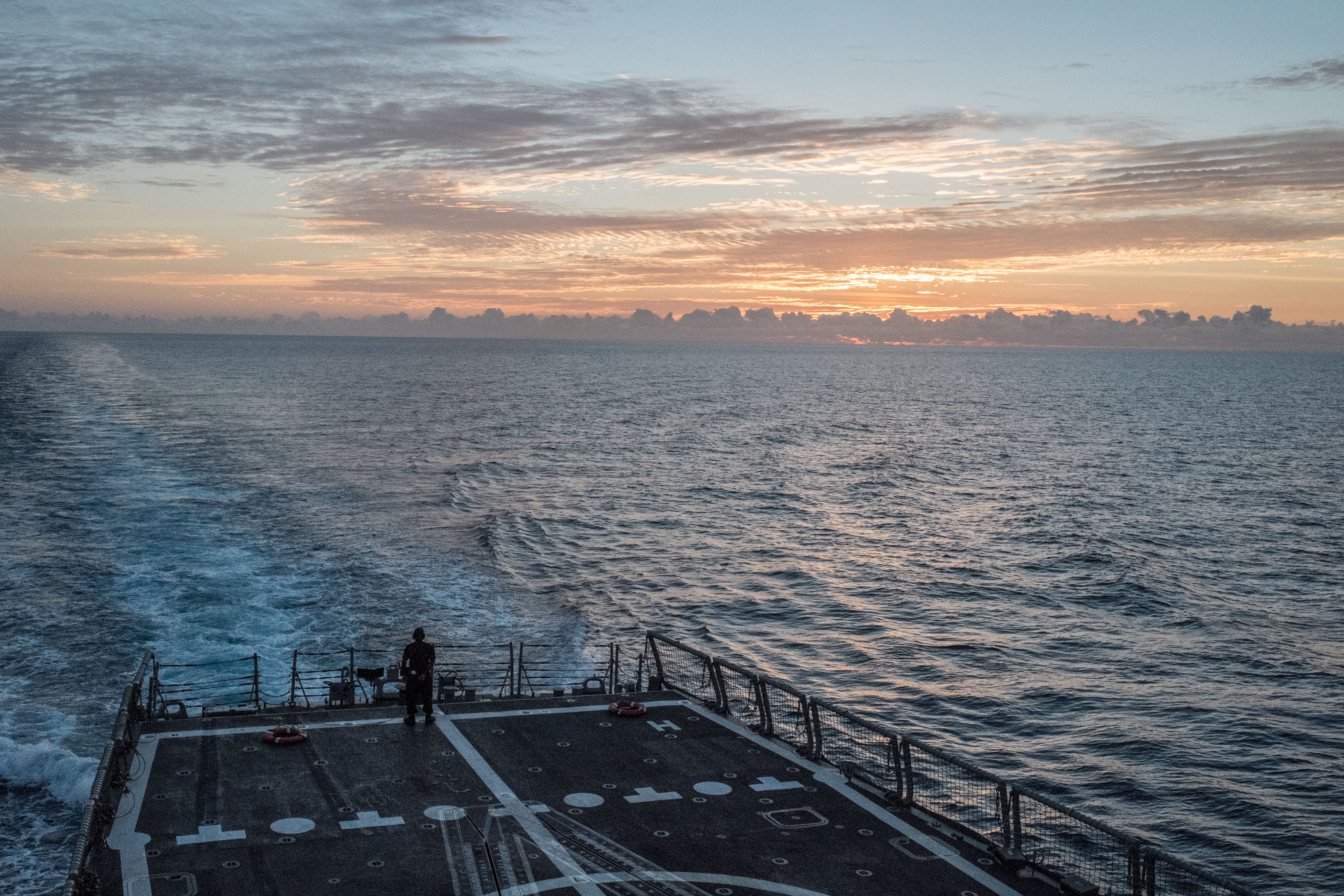ABOARD THE FRIGATE KAUFFMAN, IN THE CARIBBEAN SEA — Brady Carmack never wanted to be a frigate sailor.
He'd heard they were old, perpetually broken ships that forced their crews to jury rig gear. Word was they rocked in heavy seas.
"I've always said that I never wanted to be a frigate sailor," Carmack said. "I never set out to be one. But after serving on one I wouldn't have it any other way."
Today, Carmack — a chief gas turbine mechanic with 14 years of service — is the ship's "top snipe," the senior enlisted engineering enlisted man whom the skipper and crew rely on look to keep the frigate Kauffman running through its final frigate patrol, which began Jan. 9 in Norfolk. It is to be the last hurrah final patrol for the Oliver Hazard Perry-class ships, all of which will be gone when the decommissioned by [date]. The Kauffman is decommissioned on Sept. 21to be the last.

Cmdr. Michael Colcannon, CO of the Kauffman, works late into the night as the Navy's last frigate steams down the Florida coast.
Photo Credit: Mark D. Faram/Staff
Now serving on his second frigate, Carmack credits the ships and frigates — this is his second — and the challenges that duty aboard on them brings with taking his career to the next level, making him a better sailor and engineer. But he never aspired to frigate duty on his own.
He matured grew up as a sailor and an engineer aboard on Arleigh Burke-class destroyers, and he liked the duty on these state-of-the-art ships. During his last shore tour, he served in the Mid-Atlantic Regional Maintenance Center's gas turbine shop, breaking down engines in a way he'd never been allowed to do, or really had much need to, on a DDG.
"I told myself I'm a DDG sailor and I'm used to smooth sailing," he said in an interview in the frigate's repair division machine shop. "On destroyers everything is new and nothing breaks. We and we just run a few drills here and there, hold sweepers and do routine maintenance."
At the maintenance center, he said, he worked on turbines in the shop and also went out and helped assisted ships crews on destroyers, cruisers and frigates, to help them swap out turbines.
When it came time to take orders to sea again, he picked a destroyer. A first class petty officer looking to make chief, he was slated for duty on the destroyer Gravely, a brand new Norfolk-based ship that had yet to deploy.
"It was two weeks before I was set to transfer, and the master chief called me in," Carmack recalled. "He asked me if I wanted the good news or the bad."
The good news? Carmack would have the rest of the day off, the master chief said. Then the bad: His orders to Gravely were cancelled. He was to report instead to the USS Elrod.
"First thing out of my mouth was, 'Isn't that a frigate?' " Carmack recalled. "I never wanted to go to a frigate."
Carmack felt as if he was about to drop off the face of the earth, he said.
"So I get to the Elrod and the first month is rough — everything is breaking," he said. "I'm taking out main fuel controls, starter valves, bleeder valves. You name it, I'm doing it."
After several months, however, Over a few months, he came around. He realized he was learning his rate as he'd never done before and it dawned on him that frigate duty was about the best career move for an engineer could make.
He deployed twice with made two deployments on the Elrod and helped prepare it for its Jan. 30 her for decommissioning last year before transferring to the Kauffman in December to finish his tour.
"I realized frigate life is really not that bad," he said. "It's a little rocking, but it's not that bad. ... and, in fact, I think that for engineering sailors, the best place they can do their first tour is on a frigate," he said. "Here, they learn their rate like nowhere else.
"Here, you're really a mechanic, and it's a great starting point and building block for young engineers because you get to dig in and learn your rate" he said. "Yes, I never wanted to be a frigate sailor, but now, on my second, I have a deep respect for these ships."
A gritty pride
Kauffman's six-month deployment to U.S. Southern Command is to be the last cruise of the so-called 'ghetto Navy' — an affectionate term among sailors for the challenges of life aboard the aging frigates.
Because of their age and dwindling that maintenance dollars began do dwindle years ago, things break on these ships more often than on their shiny destroyer cousins. There's a gritty pride among frigate sailors that harkens back to their "tin can" forebears.
While the venerable USS Constitution was a frigate, and one of the most feared warships of its day, the meaning of the term frigate has changed substantially since the end of the sailing Navy. Though the fleet has only had classes of ships designated frigates since the 1960s, the idea of small, agile surface combatants goes back to the destroyer escorts of World War II.
In fact, some of today's frigates have carried on the traditions of the destroyer escorts, like the frigate Samuel B. Roberts, which shares the name with a decorated DE that saw combat in the Battle of Leyte Gulf. The frigate saw its own action of its own in 1988 when , when in 1988 it struck a mine in the Persian Gulf.
In a nod to that legacy, Navy Secretary Ray Mabus in January announced that future littoral combat ships would be redesigned "FF," becoming the next frigate class.
It's been five years since Kauffman last deployed. The ship's last cruise was cancelled because of sequestration cuts in 2013, the same year the ship's then-CO was fired for what officials called "poor performance." At the start of the 2015 cruise, more than over 60 percent of the crew hads not deployed before.
"It's a small ship and, unlike a larger ship, you get to do a lot of things — a little bit of everything," said Seaman Gardy Mercier, a Haitian native who's on his first cruise. "It's pretty interesting to be honest with you, though I'll admit that sometimes it can be disappointing because it's an old ship and everything always breaks."

Seaman Gardy Mercier stands the aft lookout watch in the rain. Frigate life is interesting, but sometimes frustrating, he said.
Photo Credit: Mark D. Faram/Staff
Mercier, a member of the ship's deck force, experienced that disappointment first hand when, in fitting ghetto Navy frigate style, Kauffman's departure was delayed a an extra day because the ship's anchor windlass broke and had to be fixed.
"Here, no one is going to face those challenges for you, you just have to step up, and man up and do it," he said. "Personally, I love it. It's great and amazing duty, and it does make you a better sailor to overcome these challenges."
Mercier says one thing he loves about this duty is the fact the crew is small and as a result he knows nearly everyone aboard.
He's not the only one who feels this way.
"We're a tight-knit group and basically just one big family," said Hull Maintenance Technician 3rd Class Dallis [cq] Dixon. "I can walk into any space aboard and shoot the s--- — pardon my language — and talk to people"
He knows that not all ships in the fleet are like frigates, but he believes he's a better sailor for serving on them. With just two and half years in the Navy, he realizes the value of having learned things on Kauffman far beyond his own rating. Dixon often works alongside snipes on auxiliary or main propulsion systems.
"So we're all going to go on to larger and newer platforms," he said. "And while everybody else is sitting around doing nothing, us old frigate sailors will be getting the [early promote recommendations] because we'll find stuff to do. That's how you are bred on a frigate."

Sailors aboard the frigate Kauffman say they are determined that the Oliver Hazard Perry-class ships go out the right way.
Photo Credit: Mark D. Faram/Staff
Dixon and his shipmates says they're focused on the deployment and finishing it right.
"It's only six months, we've got a good crew and we're going to make this happen," Dixon said. "It would take something really major to stop us."
Still, it wouldn't be a frigate cruise without some anxiety and dark humor. Some crewmembers are betting on whether the ship will survive the next six months and make it back to Norfolk on its own power.Most think it will, but there are a few naysayers.
Most in the crew don't doubt their aging ship will survive their next six months on deployment and steam back into Norfolk on time at the end.. But there are a few naysayers in the bunch - some laying odds the ship will break down may not return to the states under her own power.
The top snipe has no doubts, though.
"We'll be back, and we'll pull in on time," Carmack said. "Stuff's going to break regardless, so I'm not worried about that because when it breaks, we fix it.
"We're frigate sailors and the last of a dying breed."
Mark D. Faram is a former reporter for Navy Times. He was a senior writer covering personnel, cultural and historical issues. A nine-year active duty Navy veteran, Faram served from 1978 to 1987 as a Navy Diver and photographer.




